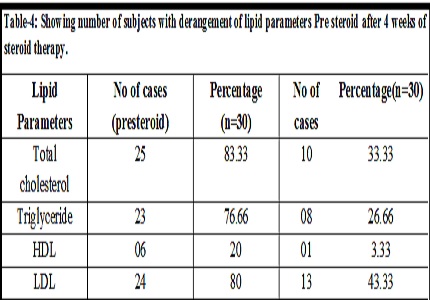Lipid profile in children with Nephrotic syndrome
Abstract
Background: To study the derangement of serum lipid profile in children 2 to 12 years with nephrotic syndrome.
Methods: 50 children 2 to 12 years with nephrotic syndrome were identified. Patients were classified as remission, relapse and newly diagnosed. Lipid Profile was measured. Patients were followed-up after 4 weeks of steroid therapy.
Results: Out of all the 50 subjects screened, 25 (50%) subjects had high total cholesterol, 26 (52%) had high triglyceride, 8 (16%) had abnormal HDL cholesterol and 25 (50%) had high LDL cholesterol. After 4 weeks of steroid therapy though there was significant reduction in lipid components.
Conclusion: Our study shows that in nephrotic syndrome, there is generalised hyperlipidemia and hypoalbuminemia. Serum cholesterol, triglycerides and LDL cholesterol were deranged in almost all subjects. In cases in relapse after 4 weeks of steroid therapy there is persistent raised total cholesterol, triglycerides and LDL cholesterol, which may predispose to the development of atherosclerosis in near future.
Downloads
References
2. Bhandari B, Mandowara SL. Lipoprotein profile in nephrotic syndrome. Indian Pediatr. 1980 May;17(5):416-9. [PubMed]
3. El-Melegy NT, Mohamed NA, Sayed MM. Oxidative modification of low density lipoprotein in relation to dyslipidemia and oxidant status in children with steroid sensitive nephrotic syndrome. Pediatr Res. 2008 Apr;63(4):404-9.
4. Ksiazek J, Ciechanowicz A, Wierzbicka A, et. el. Is dyslipidemia sustained during remission of nephritic syndrome genetically determined? Evaluation of genetic polymorphisms of proteins involved in lipoprotein metabolism in childrenand adolescents with nephrotic syndrome. Pol Arch Med Wewn. 2009 Jan-Feb;119(1-2):11-6.
5. Oetliker OH, Mordasini R, Lütschg J, et al. Lipoprotein metabolism in nephrotic syndrome in childhood. Pediatr Res. 1980 Jan;14(1):64-6. [PubMed]
6. Branten AJ, Vervoort G, Wetzels JF. Serum creatinine is a poor marker of GFR in nephrotic syndrome. Nephrol Dial Transplant. 2005 Apr;20(4):707-11. Epub 2005 Feb 15.
7. Arije A, Erasmus RT, Anjorin SA: Plasma lipids and lipoproteins cholesterol distributions in nephrotic syndrome patients during short term steroid treatment. Cent Afr J Med 1993; 39 (10): 211-5.
8. Wheeler DC, Bernard DB. Lipid abnormalities in the nephrotic syndrome: causes, consequences, and treatment. Am J Kidney Dis. 1994 Mar;23(3):331-46. [PubMed]
9. Benakappa DG, Subba Rao A, Sastry NSC: Low density lipoprotein levels in children with nephrotic syndrome; Indian paediatrics 1976; 13(4); 287-89.
10. Sreenivasa B, Sunil Kumar, Suresh Babu MT, Ragavendra K. Serum lipid profiles during onset and remission of steroid sensitive nephrotic syndrome in children; MD 49; Volume 1;Issue 1; 2015; 1-4.
11. MacLean PR, Robson JS. A simple method for determining selectivity of proteinuria. Lancet. 1967 Mar 11;1(7489):539-42. [PubMed]
12. Wanner C, Rader D, Bartens W, et al. Wieland H. Elevated plasma lipoprotein(a) in patients with the nephrotic syndrome. Ann Intern Med. 1993 Aug 15;119(4):263-9.
13. Joven J, Villabona C, Vilella E. Pattern of hyperlipoproteinaemia in human nephrotic syndrome: Influence of renal failure and diabetes mellitus. Nephron 1993; 64(4); 565-69. [PubMed]

Copyright (c) 2018 Author (s). Published by Siddharth Health Research and Social Welfare Society

This work is licensed under a Creative Commons Attribution 4.0 International License.


 OAI - Open Archives Initiative
OAI - Open Archives Initiative


